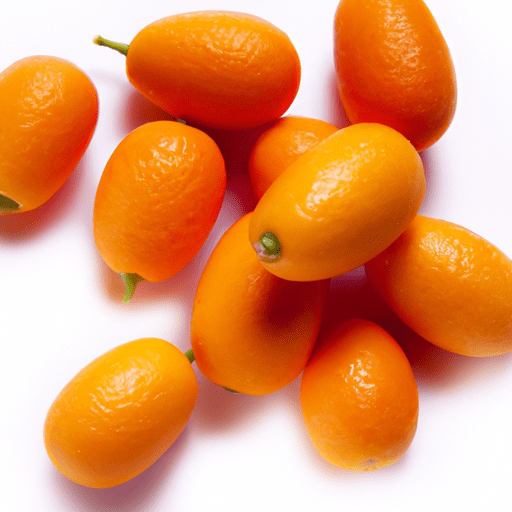All About Kumquats: A Tiny Fruit with a Burst of Flavor
Kumquats are a small but mighty fruit that often fly under the radar in the culinary world. These adorable miniature citrus fruits may be small in size, but they pack a powerful punch of flavor and are a delightful addition to any dish. In this blog post, we will explore everything you need to know about kumquats, from their unique taste and versatile uses in cooking to their nutritional value and intriguing history.
### Taste: A Perfect Balance of Sweetness and Tang
Kumquats are known for their distinctive taste, which can be described as a delightful interplay between sweetness and tanginess. Unlike other citrus fruits, kumquats have a unique feature - their sweet peel and tart flesh. When you bite into a kumquat, your taste buds are treated to an explosion of flavors. The thin, edible peel offers a burst of sweet and citrusy notes, while the juicy, acidic flesh offers a tangy zing.
### Versatile Uses in Cooking: From Sweet to Savory
Kumquats are incredibly versatile in the kitchen and can be used in an array of culinary creations. Here are some popular ways to incorporate kumquats into your recipes:
Preserves and Marmalades: The naturally high pectin content in kumquats makes them perfect for creating delicious preserves, jams, and marmalades. Their vibrant flavor infuses beautifully into spreads, perfect for slathering onto toast or pastries.
Salads and Salsas: Thinly sliced kumquats add a refreshing and tangy element to salads. Their bright color and citrusy taste bring a burst of freshness to green salads, grain bowls, and even salsas.
Marinades and Sauces: Kumquats work wonders in marinades and sauces, especially for poultry and fish dishes. The tartness cuts through rich flavors, adding a zesty kick to your favorite recipes.
Baking and Desserts: Kumquats can be used to create delightful desserts, such as pies, tarts, and cakes. They can be candied, preserved, or used as a garnish to add a touch of brightness to your sweet creations.
Cocktails and Beverages: Kumquats are the perfect ingredient to elevate cocktails and beverages. Whether muddled in a refreshing mojito or infused into a homemade liqueur, kumquats bring a unique twist to your drink repertoire.
### Nutritional Value: A Tiny Fruit Packed with Benefits
Kumquats may be small, but they are loaded with essential vitamins and minerals. Here are some key nutritional highlights:
Vitamin C: Kumquats are an excellent source of vitamin C, which helps boost the immune system and promotes healthy skin.
Fiber: These little citrus fruits are rich in dietary fiber, aiding in digestion and keeping you feeling satisfied.
Antioxidants: Kumquats are packed with antioxidants, including flavonoids and carotenoids, which help protect the body against harmful free radicals.
Low in Calories: For those watching their calorie intake, kumquats are a great choice. With only around 13 calories per fruit, they make a guilt-free snack or addition to any meal.
### History and Fun Facts: The Origin Story
Kumquats have a fascinating history that traces their roots back to China. They have been cultivated for thousands of years and were originally named “gam gwat” in Cantonese, which means “golden tangerine.” From there, they made their way to other parts of Asia, Europe, and eventually the United States.
Interestingly, kumquats are often considered a symbol of good luck and prosperity in Chinese culture. They are often given as gifts during celebrations and the Lunar New Year.
### Conclusion
In conclusion, kumquats may be small, but they make a big impact on your taste buds and culinary creations. With their unique combination of sweetness and tanginess, versatility in cooking, and impressive nutritional value, these tiny fruits deserve a place in your kitchen. Whether you are looking to add a burst of flavor to your salads, create delectable preserves, or simply snack on a low-calorie treat, kumquats are a delightful choice. So why not embrace this little gem and let the zestful goodness of kumquats enhance your next dish?
Kumquats
Origin: Kumquats are small, oval-shaped citrus fruits that belong to the Rutaceae family. They are native to China, where they have been cultivated for over 2,000 years. The name “kumquat” is derived from the Cantonese word “gam gwat,” which means “golden orange.”
Common Uses: Kumquats are often consumed whole, including the peel, as they have a sweet and tart flavor. They can be eaten raw, used in salads, marmalades, jams, chutneys, and even used in cocktails. Their small size and vibrant color make them a popular garnish for dishes and drinks.
Nutritional Benefits: Kumquats are a rich source of vitamins and minerals. They are particularly high in vitamin C, fiber, and antioxidants. Consuming kumquats may help strengthen the immune system, aid digestion, and promote healthy skin.
Unique Properties: Unlike other citrus fruits, kumquats are unique because the sweet flavor is found in the peel, while the flesh is sour. This makes them a fascinating fruit to eat whole. They also have a distinctive orange color and a shiny, edible peel. Kumquats are one of the few citrus trees that can withstand lower temperatures and are often grown in cooler climates.
Historical Significance: Kumquats have been highly regarded in Chinese culture for centuries. They are often associated with good luck and are commonly given as gifts during the Chinese New Year celebrations. Kumquat trees also hold symbolic value in traditional Chinese medicine and are believed to bring prosperity and good fortune.




Use the share button below if you liked it.
It makes me smile, when I see it.